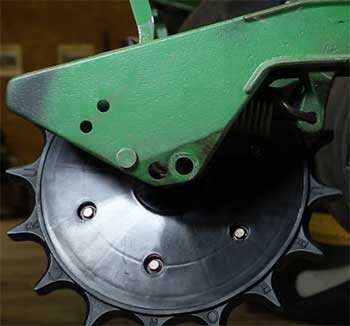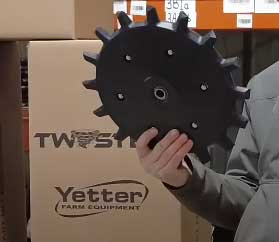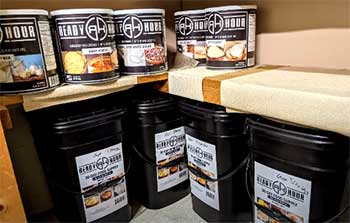The right closing wheel will give you a huge yield advantage. This is why people are interested in aftermarket closing wheels now.
Yetter Twister and Furrow Cruiser are the two most popular closing wheels. Twister is heavier, has a better yield advantage, and is pricier.
Furrow Cruiser is lighter, has less good yield advantage, and is affordable.
The right closing wheel minimizes seeding issues and gives you a yield advantage. Yetter Twister and Furrow Cruiser both are good, but which one should you pick?
Here is a comparison to help you decide.
A Quick Summary of the Comparison
| Feature | Yetter Twister | Furrow Cruiser |
| Build | Heavier, sharper spikes | Lighter, less sharp spikes |
| Yield advantage | Better | Good |
| Price and cost efficiency | Pricier, more efficient | Affordable, less efficient |
Key Differences Between Yetter Twister And Furrow Cruiser
Yetter Twister and Furrow Cruiser are practically twins in terms of performance. But they aren’t identical. And as long as things aren’t identical, there’s always room for comparison.
Build, yield advantage, price, and cost efficiency- these are the major differentiating factors between the two brands.
Let’s see how these differentiating factors work out for both closing wheels.
- Build

Twister and Furrow Cruiser both are rounded closing wheels, but there are some differences in their build.
The Twister is heavier and has slightly sharper spikes.
Furrow Cruiser on the other hand is lighter and has less aggressive spikes.
Yetter Twister has two variations- cast and poly.
The cast one has a completely round base with its signature spikes. The poly version has a hollowed base and the same signature spikes.
Either way, both versions are heavier than the Furrow Cruiser. They weigh around 5.0 lbs.
Twister also comes in a ring-only variation, you can just get the outside spike ring for your rubber wheels. But that is still heavier than the Furrow Cruiser ring-only version.
Twister spikes are longer and are better for creating deeper openings in the soil. They’re slightly more aggressive compared to the Furrow Cruiser.
Furrow Cruiser is less aggressive compared to Yetter Twister. The spikes are shorter and they’re more rounded.
These spikes are better suited for making shallow openings on the ground. The wheels themselves are lighter, standing at around 3.6 lbs. The ring-only versions are lighter than Yetter Twister too.
- Yield Advantage
This is the biggest difference between these two closing wheels. Yetter Twister is miles ahead with its yield advantage rate.
It also has a better rate for when you’re going high speed. Furrow Cruiser has a lower yield advantage overall.
According to the PFR report conducted by Beck’s, Yetter Twister wheels give you the best yield advantage. The number stands at +5.1 Bu./A. for corn and +3.8 Bu./A. for soybeans. This is the highest among almost all closing wheels in the market.

That’s not all, the Yetter Twister also performs well in speedy scenarios.
On average, Twister scored 210.9 for a 2-year multi-location closing wheel test done at 7.5mph planting speed.
Even when the speed was increased to 10 mph, the rate stood at 209.4.
Furrow Cruiser has a much lower yield advantage compared to this.
It gives +3.8 Bu./A. for corn and +1.7 Bu./A. for soybeans.
But things get interesting when you add speed to this.
Furrow Cruiser scores lower (209.9) than Yetter Twister on the speed test done at 7.5mph. But when the speed increases to 10mph, it scores better (210.0).
The problem is, this is for a fully automated Furrow Cruiser system and not the spare parts.
- Price
The price difference isn’t much if you’re just looking at the wheels. Yetter Twister retails for about $220 and Furrow Cruiser retails for around $210.
But if you want the best result from the Furrow Cruiser, you’ll need the fully automated system which costs around $2000.
Interestingly, Yetter Twister pays off faster. You’ll have to plant fewer acres to get the money back on the wheels.
Depending on the price, you’ll have to plant 83-98 acres of soybeans (on a 12-row planter) and the wheels will “pay for themselves”.
If you’re using a 16-rows planter, the number will be 111-131 acres and it will be 166-196 acres for a 24-rows planter.
For Furrow Cruisers, you’ll have to plant 125-148 acres (on a 12-rows planter) for the wheels to pay off themselves under the exact same conditions.
For 16-row planters the number is 167-197 acres and for 24-rows planters, it is 250-295 acres.
Also Read: Comparing Balance Masters With Centramatic Wheel Balancer.
Which One Should You Go With?
Both Yetter Twister and Furrow Cruiser closing wheels are really good at doing their jobs. They’re made from high-quality material and perform like that too.
So picking one of them solely based on surface-level factors is pretty hard.

But that’s just theoretical talk.
You can definitely pick one, the answer will depend on your preference.
And if you want a more objective approach, you’ll have to chalk up some pros and cons calculations.
If you’re looking for a fast payoff and don’t mind the slight aggressiveness, Yetter Twister is the best option.
Whether you’re getting cast or poly twisters, they’ll get the job done in the best way possible. Yetter twisters have a higher yield advantage even when you’re speeding along.
And the best part is, Yetter twisters pay off for themselves pretty fast. So your ROI outcome stays all-around good.
If you’re looking for less aggressive or more affordable options, Furrow Cruiser is right there for you. They have a good yield advantage and are best for minimizing sidewall compaction.
If you get the fully automated system, all you’ll have to do is drive around. The system takes care of the rest.
Furrow Cruisers have a slightly low yield advantage and take more time to pay off. But if you’re looking for something lighter, they’re a pretty hard-to-beat option.
Overall, Yetter Twister is the better option in this case. They might cost slightly more initially it pays off in the long run.
And if you’re looking for more affordable options, Copperhead’s Furrow Cruiser is as good as it gets.
Final Verdict
Aftermarket closing wheels are much better for seeding than stock ones. This is why people get them for a better yield average.
There are multiple good options like the Yetter Twister and the Furrow Cruiser. This is why there’s a whole Yetter Twister and Furrow Cruiser debate. In the end, the winner depends on your preference.
But if you want an objective answer, Yetter Twister wins all the way. And if that seems a little too aggressive or out of budget, feel free to go for Furrow Cruiser.

